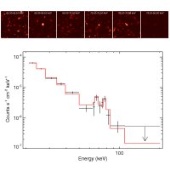ESA Science & Technology - News Archive
News archive
News archive
Published: 27 October 2006
Hubble has returned to the intriguing V838 Monocerotis many times since its initial outburst in 2002 to follow the evolution of its light echo. Two new images provide the most astonishing views of V838 to date.
Published: 26 October 2006
A dedicated study based on Hubble data of the proper motions of stars in one of our Galaxy's densest globular cluster - 47 Tucanae - has provided the best evidence yet, of the process of stellar sorting by mass inside a globular cluster.
Published: 25 October 2006
Published: 24 October 2006
Published: 23 October 2006
Hubble's new sharpest view of the Antennae galaxies reveals the merger induced star formation in great detail and provides the required resolution to determine the fate of the young super star clusters in this merger galaxy
Published: 17 October 2006
Published: 16 October 2006
New deep Hubble-ACS observations of a distant protocluster of galaxies reveals in sharp detail the infall of satellite galaxies toward the central powerful radio galaxy, a forming massive cD galaxy.
Published: 12 October 2006
The ESA director of science David Southwood invites proposers from all over the world to participate in this Announcement of Opportunity for Key Programmes of the AO-5 Cycle of Observations with INTEGRAL.
Published: 10 October 2006
By combining numerous Hubble observations taken over a 3-year period with ground based observations, a team of astronomers led by G. Fritz Benedict and Barbara E. McArthur has deduced the inclination of the nearest exoplanet's orbit around its parent star Epsilon Eridani and found it to be aligned with the star's debris disk.
Published: 10 October 2006
On 9 October 2006, Cassini performs its 20th targeted flyby of Titan. Among other science objectives, Cassini will use the RADAR instrument to image the lakes at high northern latitudes that were discovered during an earlier flyby in July this year.
Published: 9 October 2006
In a dedicated survey, the Hubble Space Telescope has discovered 16 extrasolar planet candidates orbiting a variety of distant stars in our Galaxy, and among these a new class of planets is discovered with an extremely short orbital period.
Published: 4 October 2006
Detailed simultaneous observations by the Cluster spacecraft and the TC-1 Double Star satellite, reveal new characteristics of reconnection sites at the Earth's magnetopause.
Published: 3 October 2006
Published: 3 October 2006
Published: 2 October 2006
A recent article in the Astrophysical Journal by Renaud et al. presents the results of detailed spectroimaging of the young Cassiopeia A supernova remnant with INTEGRAL IBIS/ISGRI that constrain the 44Ti signature and production models.
Published: 29 September 2006
A multilingual version of the Huygens Descent movies is now available, thanks to a collaboration between Europlanet and the ESA Communication office.
Published: 26 September 2006
Published: 22 September 2006
Astronomers analyzing two of the deepest views of the cosmos have uncovered a gold mine of galaxies, more than 500 that existed less than a billion years after the Big Bang.
Published: 22 September 2006
Following discussions at the recent informal SPC meeting in Vilspa and consultation subsequently with a number of Delegations, it has been decided that the issuance of the Call for Proposals should be postponed.
Published: 21 September 2006
—
20 Items per Page
















